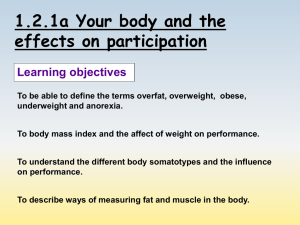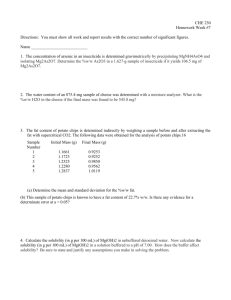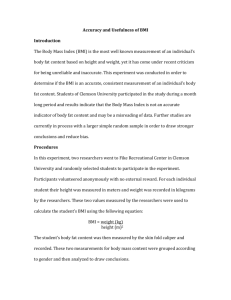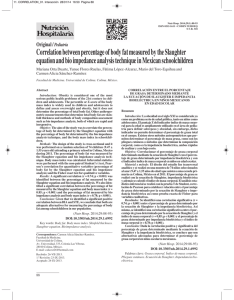INTERIM ASSESSMENT HS BIOLOGY Instructional Component 1
advertisement
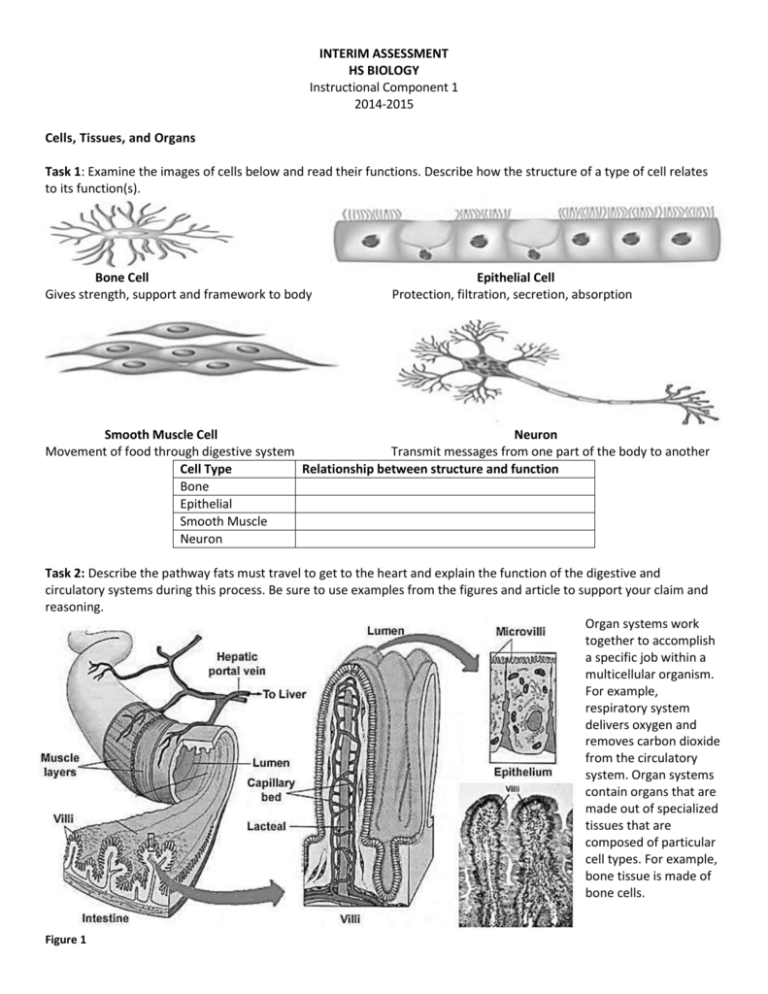
INTERIM ASSESSMENT HS BIOLOGY Instructional Component 1 2014-2015 Cells, Tissues, and Organs Task 1: Examine the images of cells below and read their functions. Describe how the structure of a type of cell relates to its function(s). Bone Cell Gives strength, support and framework to body Epithelial Cell Protection, filtration, secretion, absorption Smooth Muscle Cell Neuron Movement of food through digestive system Transmit messages from one part of the body to another Cell Type Relationship between structure and function Bone Epithelial Smooth Muscle Neuron Task 2: Describe the pathway fats must travel to get to the heart and explain the function of the digestive and circulatory systems during this process. Be sure to use examples from the figures and article to support your claim and reasoning. Organ systems work together to accomplish a specific job within a multicellular organism. For example, respiratory system delivers oxygen and removes carbon dioxide from the circulatory system. Organ systems contain organs that are made out of specialized tissues that are composed of particular cell types. For example, bone tissue is made of bone cells. Figure 1 Figure 2 Article: ScienceDaily on November 13, 2009 Fat collections linked to decreased heart function By: Boston University Medical Center Researchers from Boston University School of Medicine (BUSM) have shown that fat collection in different body locations, such as around the heart and the aorta and within the liver, are associated with certain decreased heart functions. The study, which appears online in Obesity, also found that measuring a person's body mass index (BMI) does not reliably predict the amount of undesired fat in and around these vital organs. The prevalence of obesity is rising rapidly in the United States. Recent estimates suggest that approximately 30 percent of the adult population meets this criterion. Past studies have shown that fat accumulation in the liver and around the heart are linked to cardiovascular disease and type 2 diabetes. BUSM researchers compared fat volumes in obese persons (BMI over 30), all of whom had high blood pressure and/or diabetes, and lean healthy persons (average BMI of 22). All subjects underwent magnetic resonance imaging (MRI) and proton MR spectroscopy to quantify pericardial and peri-aortic lipid volumes, cardiac function, aortic compliance and intra-hepatic lipid content. Fasting plasma lipoproteins, glucose, insulin, and free fatty acids were also measured among the subjects. The researchers found fat collections in anatomically separate locations, such as within the liver and around the heart, to be associated to cardiovascular function -- including a decrease in cardiac pumping function -- as fat around the heart increased. However, they also found that the amount of fat around the heart and aorta was not predicted by the BMI of the individual in this population. "Our study found that fat collection around the heart, the aorta and within the liver is clearly associated with decreased heart functions and that an MRI can quickly and noninvasively measure fat volume in these areas. Our study also found that looking at BMI of the individual does not reliably predict the amount of undesired fat in and around organs," said James Hamilton, PhD, senior author and project leader, and a professor of biophysics, physiology and biomedical engineering at BUSM. Source : Boston University Medical Center. "Fat collections linked to decreased heart function." <www.sciencedaily.com/releases/2009/11/091113101423.htm> STOP INTERIM ASSESSMENT HS BIOLOGY Instructional Component 1 2014-2015 Carbon-Carbon John, a student at U.S.A. High School was having a conversation with his friend, Cindy, after leaving their Biology class. John said, “Mr. Jones said we were carbon based. I know I'm probably missing something obvious, but how exactly are we carbon based? What determines this? We're about 60% water, made up of hydrogen and oxygen, bones are calcium, there’s lots of iron in blood, so why do we say we are ‘carbon based’?" Help Cindy explain to John why we are “carbon based” by completing the following three tasks. Task 1: Cindy looks in her backpack and pulls out three notecards from class, each containing one of the structures below. List at least two similarities and two differences between the three molecules. Describe the structure and identify the atoms that make each molecule. Sugar Amino Acids Saturated Fatty Acid Figure 1 Task 2: Cindy then directs John to consider the products and reactants of cellular respiration and photosynthesis (Figure 2). Using the information in Figures 1 and 2, explain how a carbon atom in the atmosphere may be eventually incorporated into various molecules in a living cell. Make sure that you address how carbon, hydrogen, and oxygen from sugar molecules may combine with other elements to form amino acids and/or other large carbon-based molecules. Photosynthesis 6CO2 + 6H2O + Sunlight C6H12O6 + 6O2 Cellular Respiration C6H12O6 + 6O2 6CO2 + 6H2O + energy (36ATP) Figure 2 Continue to the next page Task 3: Finally, Cindy describes that as matter and energy flow through different organizational levels of living systems, chemical elements are recombined in different ways to form different products. Explain how important molecules for living systems, such as proteins and nucleic acids are produced using what you learned in class and information in Figures 1, 2, and 3. Be sure to describe the flow of energy and include the role of photosynthesis, cellular respiration, and ATP. Figure 3







